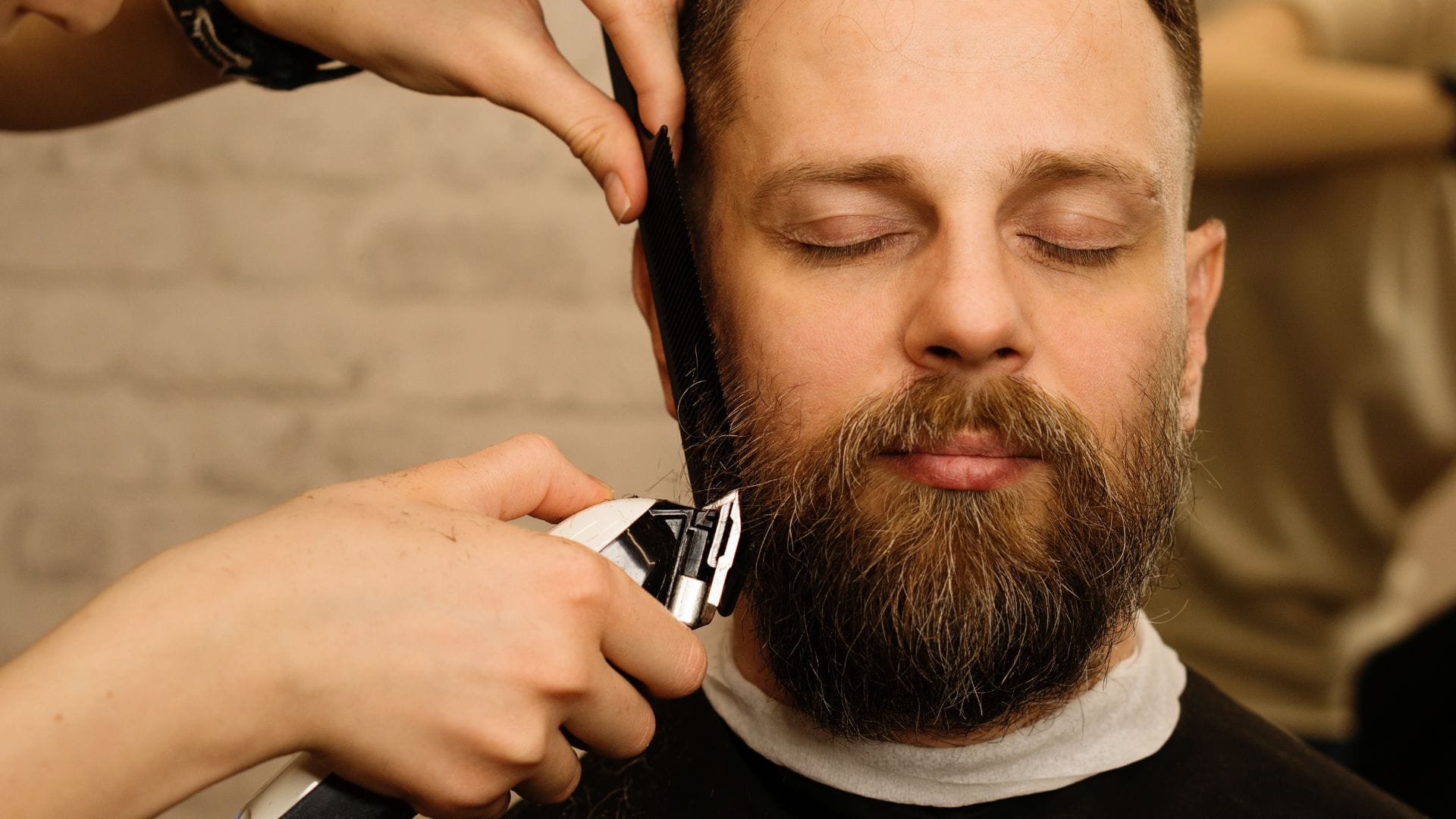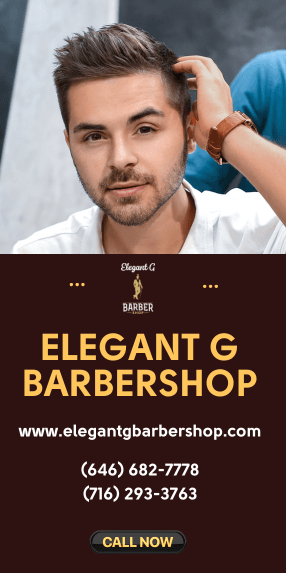In the bustling world of men’s grooming, maintaining a sharp, well-kept look is paramount. Regular hair and beard maintenance not only enhances your appearance but also boosts confidence and personal style. This guide will help you identify when it’s time for a trim, ensuring you stay at the top of your grooming game.
The Tell-Tale Signs It’s Time for a Trim
1. Split Ends and Frizz
Split ends are a clear indicator that your hair is in dire need of a trim. When the ends of your hair start to split, it means the protective outer layer of your hair has been compromised, causing the inner layers to fray. This not only makes your hair look unhealthy but also gives it a rough texture. If left unchecked, split ends can travel up the hair shaft, leading to further damage and breakage. This is why regular trims are essential—they help to remove these damaged ends and prevent the problem from escalating.
Similarly, increased frizz is often a sign that your hair is losing its shape and integrity. Frizz occurs when the outer layer of the hair, known as the cuticle, becomes raised, allowing moisture to enter the hair shaft and swell it. This can be exacerbated by factors such as humidity, over-styling, and the use of harsh hair products. A professional trim can help manage frizz by removing damaged or dry ends, promoting a sleeker and more polished appearance. Additionally, they can recommend products and treatments tailored to your hair type to maintain control over frizz between trims. Regular maintenance will ensure your hair stays in optimal health, radiating vitality and strength.
2. Lack of Shape in Your Beard
A well-groomed beard should have a defined shape. When your beard starts to look unruly and loses its contour, it’s a sign that a beard trim is overdue. This not only keeps your facial hair neat but also complements your overall facial structure. An unkempt beard can quickly detract from your appearance, making you look less polished and more disheveled. Regular trims help maintain the desired outline of your beard, accentuating your jawline and providing a clear definition between your facial hair and skin.
A professional barber can sculpt your beard to suit your face shape, achieving a balanced and harmonious look. Whether you prefer a sharp, angular beard or a more natural, rounded shape, the expertise of a skilled barber ensures symmetry and precision. Additionally, regular trims can address uneven growth patterns, where certain areas of your beard may grow faster than others, leading to an imbalanced look. By trimming these areas, you foster a more uniform and aesthetically pleasing beard.
Furthermore, maintaining the shape of your beard helps in managing the texture and coarseness of the hair. As the hair grows out, it can become wiry and difficult to control, making daily grooming more arduous. Trimming removes split ends and promotes healthier growth, enhancing the overall quality of your beard. Adhering to a consistent trimming routine not only keeps your beard in top condition but also reinforces your commitment to personal grooming, reflecting confidence and attention to detail.
3. Hair Falling Flat
If your hairstyle feels lifeless and lacks volume, it’s likely time for a trim. Over time, hair can become weighed down by excess length, leading to a flat and lackluster appearance. A haircut helps remove this weight, rejuvenating your hair’s natural bounce and vitality. By taking off the ends, you create lighter, healthier strands that can better hold styles and exhibit more movement.
Trimming not only removes the heaviness but also helps get rid of damaged or split ends, which can cause hair to look frizzy and dull. Healthier ends mean that your hair will reflect light more effectively, appearing shinier and more vibrant. This can make a significant difference, particularly for those with fine or straight hair prone to looking limp and deflated.
Moreover, specific cutting techniques, such as layering or texturizing, can add dimension and breath new life into your hairstyle. Layers help create the illusion of depth and volume by removing some interior weight, allowing the top layers to lift and separate. Texturizing can also provide additional lift by reducing bulk in certain areas, making it easier to style and maintain that voluminous look.
4. Increased Tangling
Frequent tangling and knots in your hair can indicate that your ends are damaged and need trimming. When hair strands experience split ends or breakage, their rough texture can easily get intertwined, causing tangles. Regular trims help maintain the smoothness and manageability of your locks. By cutting off the damaged ends, you prevent the formation of knots and make daily brushing easier and less painful.
Healthy hair ends slide past each other effortlessly, reducing friction and the chance of tangling. Moreover, removing damaged portions of the hair promotes even length and strength throughout your mane, which in turn discourages the development of tangles. Regular trims can also facilitate better hair growth by eliminating split ends before they travel further up the shaft, thereby maintaining the integrity of your hair.
In addition to keeping your hair tangle-free, consistent trimming deters other issues such as matting and breakage, which can further exacerbate tangling. By integrating regular haircuts into your hair care routine, you can sustain the health and appearance of your locks, ensuring they remain smooth, shiny, and tangle-free. Regular maintenance not only enhances the style and aesthetics of your hair but also makes it significantly more manageable day-to-day.
5. Overgrown Sideburns and Neck Hair
Sideburns and neck hair can grow faster than you realize. When they start to look bushy or extend beyond your desired lines, it’s a clear signal to visit your barber. Overgrown sideburns can disrupt the clean contours of your face, making your hairstyle appear untidy and unpolished. Similarly, neck hair that creeps down towards your collar or spreads out can ruin the overall groomed look you aim to maintain.
Regularly trimming these areas not only keeps your appearance sharp but also highlights your facial features and hairstyle. It’s recommended to pay attention to these often overlooked areas every couple of weeks, as they tend to grow at a different pace compared to the rest of your hair. During your barber visit, you can request a quick cleanup or a detailed shaping that compliments your haircut.
Maintaining well-groomed sideburns and neck hair can significantly enhance your overall presentation, ensuring that you look your best from every angle. Even if you’re growing out your hair, keeping these regions neat will give you a more refined and intentional look. Investing in these small grooming practices makes a big difference in how polished and professional you appear daily.
Seasonal Maintenance
Adapting to Seasonal Changes
Different seasons can significantly impact your grooming routine. For instance, summer heat may necessitate more frequent trims to keep your hair light and manageable, especially if you’re prone to sweating or spending time outdoors. Shorter hairstyles in the summer can help you stay cool and reduce the maintenance required to keep your hair looking fresh. Additionally, the increased exposure to sun, chlorine, and saltwater can take a toll on your hair, necessitating regular treatments and trims to prevent dryness and damage.
On the other hand, winter might call for maintaining a bit more length for warmth. As temperatures drop, having slightly longer hair can provide a buffer against the cold, protecting your scalp and ears. However, winter also brings its own set of challenges, such as dry air and indoor heating, which can lead to brittle hair and split ends. Ensuring your hair remains well-moisturized through conditioning treatments is essential during these colder months.
Adjusting your trim schedule with the seasons ensures your grooming is always on point. In fall and spring, transitional seasons, you might need to refine your hairstyle to accommodate the changing weather. For example, fall might be a good time to prepare your hair for the dryness of winter with nourishing treatments, while spring could be perfect for shedding any additional length gained during the winter months.
Overall, being mindful of seasonal changes and their impact on your hair can help you maintain a stylish and polished appearance year-round. By tailoring your grooming routine to the specific needs of each season, you ensure your hair remains healthy, manageable, and attractive regardless of the time of year.
Finding the Right Barber
Research and Reviews
Choosing the right New York barber is crucial for maintaining your style. Begin your search by seeking out barbers with positive reviews online. Websites like Yelp, Google Reviews, and social media platforms often provide insights into the experiences of other clients. Look for consistent praise regarding the barber’s skill, professionalism, and the overall atmosphere of the barbershop.
In addition to online reviews, examine the barber’s portfolio. Many barbers showcase their work through personal websites or social media channels like Instagram. Assess their portfolio to determine if their style aligns with your desired look. Consider their versatility—can they handle various types of haircuts and styles? A well-rounded portfolio indicates a barber who is adept at catering to different preferences and hair types.
Personal recommendations can also be invaluable in your search. Ask friends, family members, or colleagues whose haircuts you admire for their barber’s contact information. Word-of-mouth referrals often lead to high-quality barbers who might not have a significant online presence. When you trust the opinions of people you know, you can feel more confident about trying a new barber.
Ultimately, investing time in research and leveraging reviews and recommendations can lead you to a barber who consistently delivers excellent results, ensuring your grooming routine remains impeccable.
Consultation and Communication
A good barber will take the time to understand your preferences and provide a consultation before cutting. This initial step is crucial for ensuring that the barber is fully aware of your desired look. During a consultation, you should discuss the specifics of your haircut, including the length, style, and any particular details you want to incorporate. Visual aids, such as photos or sketches, can be extremely helpful in conveying your vision clearly.
Don’t hesitate to communicate exactly what you want—clarity ensures you get the perfect trim every time. Be specific about aspects such as how you part your hair, the level of fade you prefer, and even the type of products you use. If you’re unsure, ask for the barber’s professional opinion—they can offer valuable advice tailored to your hair type and face shape. Effective communication builds a rapport with your barber, making future visits more relaxed and productive.
Furthermore, a skilled barber will not only listen but also ask questions to clarify any uncertainties. They might suggest slight modifications to enhance the overall look or to better suit your hair texture and growth patterns. Open dialogue fosters mutual understanding and can prevent potential disappointments. Remember, the goal is to walk out of the New York barbershop with a haircut that not only meets but exceeds your expectations.
At-Home Maintenance
Regular Washing and Conditioning
Keeping your hair and beard clean is essential for maintaining both appearance and health. Regular washing removes dirt, excess oil, and product buildup, which can otherwise lead to scalp issues or dull-looking hair. Use a quality shampoo that suits your hair type; whether it’s oily, dry, or normal, selecting the right product will yield the best results.
Follow up with a good conditioner to keep your hair hydrated and smooth. Conditioning helps to replenish moisture lost during washing and can prevent split ends and breakage. For your beard, choose a beard-specific shampoo and conditioner to cater to the coarser hair follicles. These products are specially formulated to nourish and soften facial hair, while also benefiting the underlying skin.
Consistency is key—aim to wash and condition your hair and beard at least two to three times a week, depending on your lifestyle and needs. Over-washing can strip away natural oils, so it’s essential to find a balanced routine. Additionally, using lukewarm water instead of hot water can help to retain moisture and prevent drying out your hair.
Incorporating these practices into your grooming routine ensures that both your hair and beard stay clean, manageable, and healthy between barbershop visits. Regular maintenance not only enhances your appearance but also contributes to the longevity of your desired style.
Daily Grooming Habits
Investing in good grooming tools such as combs, brushes, and trimmers is essential to keep your beard and hair looking fresh and well-maintained. A high-quality comb or brush not only makes styling easier but also helps in maintaining the health of your hair and beard. Regularly brushing your beard and hair prevents tangles, which can lead to breakage and an unkempt appearance. Additionally, brushing distributes natural oils evenly along the hair shaft and throughout your beard, fostering a healthier and shinier look.
When choosing a comb, opt for one made of wood or another material that doesn’t generate static electricity, as this can cause frizz and damage. For brushes, boar bristle brushes are highly recommended for their ability to gently detangle while distributing oils. These types of brushes mimic the natural movement of your scalp and face, ensuring that every strand is cared for.
Trimmers are another crucial tool in your grooming arsenal. A good quality trimmer allows for precise trimming and shaping, helping you maintain your desired style with ease. Whether you prefer a clean line around your beard or a consistently trimmed hairline, having a reliable trimmer can make a world of difference. Look for trimmers with multiple guard sizes to give you flexibility with different lengths, and ensure that the blades are sharp and well-maintained to avoid any pulling or discomfort.
Incorporating these tools into your daily grooming routine will make maintaining your hair and beard much simpler and more effective. Brushing your hair and beard at least once a day not only detangles but also encourages healthier growth by promoting better blood circulation. Regularly trimming helps in keeping split ends at bay and maintaining a polished look.
By dedicating a few minutes each day to grooming with the right tools, you’ll ensure that your hair and beard remain in top condition, enhancing your overall appearance and confidence.
Frequently Asked Questions about Men’s Hair Trim
How often should I trim my hair?
The frequency of hair trims depends on your hairstyle and hair growth rate. Generally, getting a trim every 4-6 weeks helps maintain the shape and health of your hair, but if you prefer a longer style, you might extend it to every 8-12 weeks.
Can I trim my own hair at home?
Yes, you can trim your hair at home with the right tools and some practice. Investing in a good quality trimmer with multiple guard sizes and watching tutorial videos can help you achieve a decent trim. However, for more complex styles, visiting a professional stylist is recommended.
What is the best time of day to trim my hair?
There is no specific time of day that is universally better for trimming hair. It’s essential to choose a time when you are relaxed and can take your time. Some people find it convenient to trim their hair in the morning when they are fresh and focused.
Should I trim my hair wet or dry?
There are differing opinions on this, but many barbers recommend trimming hair when it is dry. Dry hair allows for more accurate results as it shows the true length and shape. If you prefer to trim while wet, ensure your hair is only slightly damp rather than dripping wet.
How can I avoid split ends?
Regular trims are crucial to avoid split ends. Even if you are growing your hair out, trimming the ends every 8-12 weeks can prevent split ends from traveling up the hair shaft and causing more damage.
What should I do if I over-trim my hair?
If you accidentally trim too much, don’t panic. Hair will eventually grow back. In the meantime, you can visit a professional to reshape your hair and even out any uneven cuts. Wearing your hair in a different style or using styling products can also help blend the over-trimmed areas.
Are there specific products I should use after trimming my hair?
After trimming your hair, it’s beneficial to use a leave-in conditioner or hair serum to keep your hair moisturized and healthy. Products with natural oils like argan or jojoba oil can help nourish your hair and protect against damage.
Stay Sharp and Stylish
Regular trims are key to maintaining a polished and stylish look. They prevent damage, enhance your appearance, and ensure your hair and beard always look their best. Ready to elevate your grooming routine? Book an appointment with your favorite barber today and experience the difference a professional trim can make.


